Microcontact-Printed Optical Biosensor for Non-Invasive Detection of TNF-α: Point-of-Care Monitoring of Heart Failure
Abstract
1. Introduction
2. Materials and Methods
2.1. Chemicals and Reagents
2.2. Preparation of Silicon Mold
2.3. PDMS Stamp Fabrication
2.4. PDMS Silanization with PFDTS
2.5. Micro Contact Printing with Ink
2.6. Micro Contact Printing with TSEUD
2.7. PDMS Biofunctionalization and TNF-α Detection
2.8. Wettability
2.9. Fluorescence Microscopy
3. Results and Discussion
3.1. Micro Contact Printing µCP
3.2. Cytokines Detection
4. Conclusions
Supplementary Materials
Author Contributions
Funding
Institutional Review Board Statement
Informed Consent Statement
Data Availability Statement
Conflicts of Interest
References
- Savarese, G.; Becher, P.M.; Lund, L.H.; Seferovic, P.; Rosano, G.M.C.; Coats, A.J.S. Global Burden of Heart Failure: A Comprehensive and Updated Review of Epidemiology. Cardiovasc. Res. 2023, 118, 3272–3287. [Google Scholar] [CrossRef]
- Bekele, F.; Sheleme, T.; Tsegaye, T.; Parameswari, S.A.; Syed, M.A.; Tafese, L.; Gezimu, W. Prevalence and risk factors of mortality among heart failure patients in low resource setting hospitals: A multicenter prospective observational study. Front. Cardiovasc. Med. 2024, 11, 1429513. [Google Scholar] [CrossRef]
- McDonagh, T.A.; Metra, M.; Adamo, M.; Gardner, R.S.; Baumbach, A.; Böhm, M.; Burri, H.; Butler, J.; Čelutkienė, J.; Chioncel, O.; et al. 2021 ESC Guidelines for the Diagnosis and Treatment of Acute and Chronic Heart Failure. Eur. Heart J. 2021, 42, 3599–3726. [Google Scholar] [CrossRef]
- Nadar, S.K.; Shaikh, M.M. Biomarkers in Routine Heart Failure Clinical Care. Card. Fail. Rev. 2019, 5, 50–56. [Google Scholar] [CrossRef]
- Licordari, R.; Correale, M.; Bonanno, S.; Beltrami, M.; Ciccarelli, M.; Micari, A.; Palazzuoli, A.; Dattilo, G. Beyond Natriuretic Peptides: Unveiling the Power of Emerging Biomarkers in Heart Failure. Biomolecules 2024, 14, 309. [Google Scholar] [CrossRef]
- Biasucci, L.M.; Maino, A.; Grimaldi, M.C.; Cappannoli, L.; Aspromonte, N. Novel Biomarkers in Heart Failure: New Insight in Pathophys-iology and Clinical Perspective. J. Clin. Med. 2021, 10, 2771. [Google Scholar] [CrossRef]
- Carris, N.W.; Mhaskar, R.; Coughlin, E.; Bracey, E.; Tipparaju, S.M.; Halade, G.V. Novel Biomarkers of Inflammation in Heart Failure with Preserved Ejection Fraction: Analysis from a Large Prospective Cohort Study. BMC Cardiovasc. Disord. 2022, 22, 221. [Google Scholar] [CrossRef]
- Jaric, S.; Kudriavtseva, A.; Nekrasov, N.; Orlov, A.V.; Komarov, I.A.; Barsukov, L.A.; Gadjanski, I.; Nikitin, P.I.; Bobrinetskiy, I. Femtomolar Detection of the Heart Failure Bi-omarker NT-proBNP in Artificial Saliva Using an Immersible Liquid-Gated Aptasensor with Reduced Graphene Oxide. arXiv 2023, arXiv:2307.16692. [Google Scholar] [CrossRef]
- Nunes, L.A.S.; Mussavira, S.; Bindhu, O.S. Clinical and Diagnostic Utility of Saliva as a Non-Invasive Diagnostic Fluid: A Systematic Review. Biochem. Med. 2015, 25, 177–192. [Google Scholar] [CrossRef]
- Bahbah, E.I.; Noehammer, C.; Pulverer, W.; Jung, M.; Weinhaeusel, A. Salivary biomarkers in cardiovascular disease: An insight into the current evidence. FEBS J. 2021, 288, 6392–6405. [Google Scholar] [CrossRef]
- Klimiuk, A.; Zalewska, A.; Knapp, M.; Skutnik-Radziszewska, A.; Maciejczyk, M. Could Inflammation Contribute to Salivary Gland Dysfunction in Patients with Chronic Heart Failure? Front. Immunol. 2022, 13, 1005981. [Google Scholar] [CrossRef]
- Rammos, A.; Bechlioulis, A.; Kalogeras, P.; Tripoliti, E.E.; Goletsis, Y.; Kalivi, A.; Blathra, E.; Salvo, P.; Trivella, M.G.; Lomonaco, T.; et al. Salivary Biomarkers for Diagnosis and Therapy Monitoring in Patients with Heart Failure. A Systematic Review. Diagnostics 2021, 11, 824. [Google Scholar] [CrossRef]
- Assareh, A.; Haybar, H.; Yoosefi, H.; Bozorgmanesh, M. Bedside-Friendly Prediction for Presence of Post-Myocardial Infarction Systolic Dysfunction Using Multimarker Panel: Integrating Salivary Diagnostics into Clinical Practice. Korean Circ. J. 2013, 43, 246–254. [Google Scholar] [CrossRef] [PubMed][Green Version]
- Dekker, R.L.; Lennie, T.A.; Moser, D.K.; Miller, C.S.; Ebersole, J.L.; Chung, M.L.; Campbell, C.L.; Bailey, A.; Tovar, E.G. Salivary Biomarkers, Oral Inflammation, and Functional Status in Patients with Heart Failure. Biol. Res. Nurs. 2017, 19, 153–161. [Google Scholar] [CrossRef] [PubMed]
- Lequin, R.M. Enzyme Immunoassay (EIA)/Enzyme-Linked Immunosorbent Assay (ELISA). Clin. Chem. 2005, 51, 2415–2418. [Google Scholar] [CrossRef] [PubMed]
- Khozeymeh, F.; Mortazavi, M.; Khalighinejad, N.; Akhavankhaleghi, M. Salivary Levels of Interleukin-6 and Tumor Necrosis Factor-α in Patients Undergoing Hemodialysis. Dent. Res. J. 2016, 13, 69–73. [Google Scholar] [CrossRef]
- Lu, Y.; Zhou, Q.; Xu, L. Non-Invasive Electrochemical Biosensors for TNF-α Cytokines Detection in Body Fluids. Front. Bioeng. Biotechnol. 2021, 9, 701045. [Google Scholar] [CrossRef]
- Aydın, S.; Emre, E.; Uğur, K.; Aydın, M.A.; Şahin, İ.; Çınar, V.; Akbulut, T. An over-view of ELISA: A review and update on best laboratory practices for quantifying peptides and proteins in biological fluids. J. Int. Med. Res. 2025, 53, 3000605251315913. [Google Scholar] [CrossRef]
- Baraket, A.; Ghedir, E.K.; Zine, N.; Jaffrezic Renault, N.; Aarfane, A.; Nasrellah, H.; Bel-hora, F.; Bonet, F.P.; Bausells, J.; Errachid, A. Electrochemical Immunosensor Prototype for N Terminal Natriuretic Peptide Detection in Human Saliva: Heart Failure Biomedical Application. Chemosensors 2025, 13, 66. [Google Scholar] [CrossRef]
- Baraket, A.; Lee, M.; Zine, N.; Caruso, R.; Trivella, M.G.; Errachid, A. Electrochemical Biosensor for Interleukin 10 Detection in Real Human Plasma: Heart Failure Biomedical Application. Int. J. Cardiovasc. Res. 2017, 6, 1. [Google Scholar] [CrossRef]
- Baraket, A.; Lee, M.; Zine, N.; Sigaud, M.; Bausells, J.; Errachid, A. A Fully Integrated Electrochemical Biosensor Platform Fabrication Process for Cytokine Detection. Biosens. Bioelectron. 2017, 93, 170–175. [Google Scholar] [CrossRef] [PubMed]
- Barhoumi, L.; Bellagambi, F.G.; Vivaldi, F.M.; Baraket, A.; Clément, Y.; Zine, N.; Ben Ali, M.; Elaissari, A.; Errachid, A. Ultrasensitive Immunosensor Array for TNF-α Detec-tion in Artificial Saliva Using Polymer Coated Magnetic Microparticles onto Screen Print-ed Gold Electrode. Sensors 2019, 19, 692. [Google Scholar] [CrossRef]
- Bellagambi, F.G.; Baraket, A.; Longo, A.; Vatteroni, M.; Zine, N.; Bausells, J.; Fuoco, R.; Di Francesco, F.; Salvo, P.; Karanasiou, G.S.; et al. Electrochemical Biosensor Platform for TNF-α Cytokine Detection in Both Artificial and Human Saliva: Heart Failure. Sens. Actuators B Chem. 2017, 251, 1026–1033. [Google Scholar] [CrossRef]
- Ghedir, E.K.; Baraket, A.; Benounis, M.; Zine, N.; Errachid, A. Electrochemical Multi-plexed N Terminal Natriuretic Peptide and Cortisol Detection in Human Artificial Saliva: Heart Failure Biomedical Application. Chemosensors 2023, 11, 416. [Google Scholar] [CrossRef]
- Baraket, A.; Lee, M.; Zine, N.; Yaakoubi, N.; Bausells, J.; Errachid, A. A Flexible Electrochemical Micro Lab on Chip: Ap-plication to the Detection of Interleukin 10. Microchim. Acta 2016, 183, 2155–2162. [Google Scholar] [CrossRef]
- Homola, J. Surface Plasmon Resonance Sensors for Detection of Chemical and Biological Species. Chem. Rev. 2008, 108, 462–493. [Google Scholar] [CrossRef]
- Lohcharoenkal, W.; Abbas, Z.; Rojanasakul, Y. Advances in Nanotechnology-Based Biosensing of Immunoregulatory Cytokines. Biosensors 2021, 11, 364. [Google Scholar] [CrossRef]
- Damborský, P.; Švitel, J.; Katrlík, J. Optical Biosensors. Essays Biochem. 2016, 60, 91–100. [Google Scholar] [CrossRef]
- Mostufa, S.; Rezaei, B.; Ciannella, S.; Yari, P.; Gómez-Pastora, J.; He, R.; Wu, K. Advancements and Perspectives in Optical Biosensors. ACS Omega 2024, 9, 24181–24202. [Google Scholar] [CrossRef]
- Xia, Y.; Whitesides, G.M. Soft Lithography. Angew. Chem. Int. Ed. 1998, 37, 550–575. [Google Scholar] [CrossRef]
- Qin, D.; Xia, Y.; Whitesides, G.M. Soft Lithography for Micro- and Nanoscale Patterning. Nat. Protoc. 2010, 5, 491–502. [Google Scholar] [CrossRef]
- Bernard, A.; Delamarche, E.; Schmid, H.; Michel, B.; Biebuyck, H. Printing Patterns of Proteins. Langmuir 2000, 14, 2225–2229. [Google Scholar] [CrossRef]
- Delamarche, E.; Bernard, A.; Schmid, H.; Michel, B.; Biebuyck, H. Patterned Delivery of Immunoglobulins to Surfaces Using Microfluidic Networks. Science 1997, 276, 779–781. [Google Scholar] [CrossRef]
- Baraket, A.; Lee, M.; Zine, N.; Sigaud, M.; Yaakoubi, N.; Trivella, M.G.; Zabalad, M.; Bausells, J.; Jaffrezic Renault, N.; Errachid, A. Diazonium Modified Gold Microelec-trodes onto Polyimide Substrates for Impedimetric Cytokine Detection with an Integrated Ag/AgCl Reference Electrode. Sens. Actuators B Chem. 2013, 189, 165–172. [Google Scholar] [CrossRef]
- Lee, M.; Lopez-Martinez, M.J.; Baraket, A.; Zine, N.; Errachid, A.; Jaffrezic-Renault, N.; Bausells, J. Combination of PDMS Microfilters and Micromixers Based on Flexible Thermoplastic Films for Size Sorting and Mixing of Microparticles. J. Appl. Polym. Sci. 2015, 132, 42088. [Google Scholar] [CrossRef]
- Baraket, A.; Zine, N.; Lee, M.; Bausells, J.; Jaffrezic-Renault, N.; Bessueille, F.; Yaakoubi, N.; Errachid, A. Development of a Flexible Microfluidic System Based on a Simple and Reproducible Sealing Process between Polymers and Poly(dimethylsiloxane). Microelectron. Eng. 2013, 110, 173–177. [Google Scholar] [CrossRef]
- Lee, M.; Baraket, A.; Zine, N.; Zabala, M.; Campabadal, F.; Caruso, R.; Trivella, M.G.; Jaffrezic-Renault, N.; Errachid, A. A novel three-dimensional biosensor based on aluminum oxide: Application for early-stage detection of human interleukin-10. Methods Mol. Biol. 2014, 1172, 49–64. [Google Scholar]
- Bougrini, M.; Baraket, A.; Jamshaid, T.; El Aissari, A.; Bausells, J.; Zabala, M.; El Bari, N.; Bouchikhi, B.; Jaffrezic-Renault, N.; Abdelhamid, E.; et al. Development of a novel capacitance electrochemical biosensor based on silicon nitride for ochratoxin A detection. Sens. Actuators B Chem. 2016, 234, 446–452. [Google Scholar] [CrossRef]
- Lee, M.; Zine, N.; Baraket, A.; Zabala, M.; Campabadal, F.; Caruso, R.; Trivella, M.G.; Jaffrezic-Renault, N.; Errachid, A. A novel biosensor based on hafnium oxide: Application for early stage detection of human interleukin-10. Sens. Actuators B Chem. 2012, 175, 201–207. [Google Scholar] [CrossRef]
- Fuard, D.; Tzvetkova-Chevolleau, T.; Decossas, S.; Tracqui, P.; Schiavone, P. Optimiza-tion of Poly(dimethylsiloxane) (PDMS) Substrates for Studying Cellular Adhesion and Motility. Microelectron. Eng. 2008, 85, 1289–1293. [Google Scholar] [CrossRef]
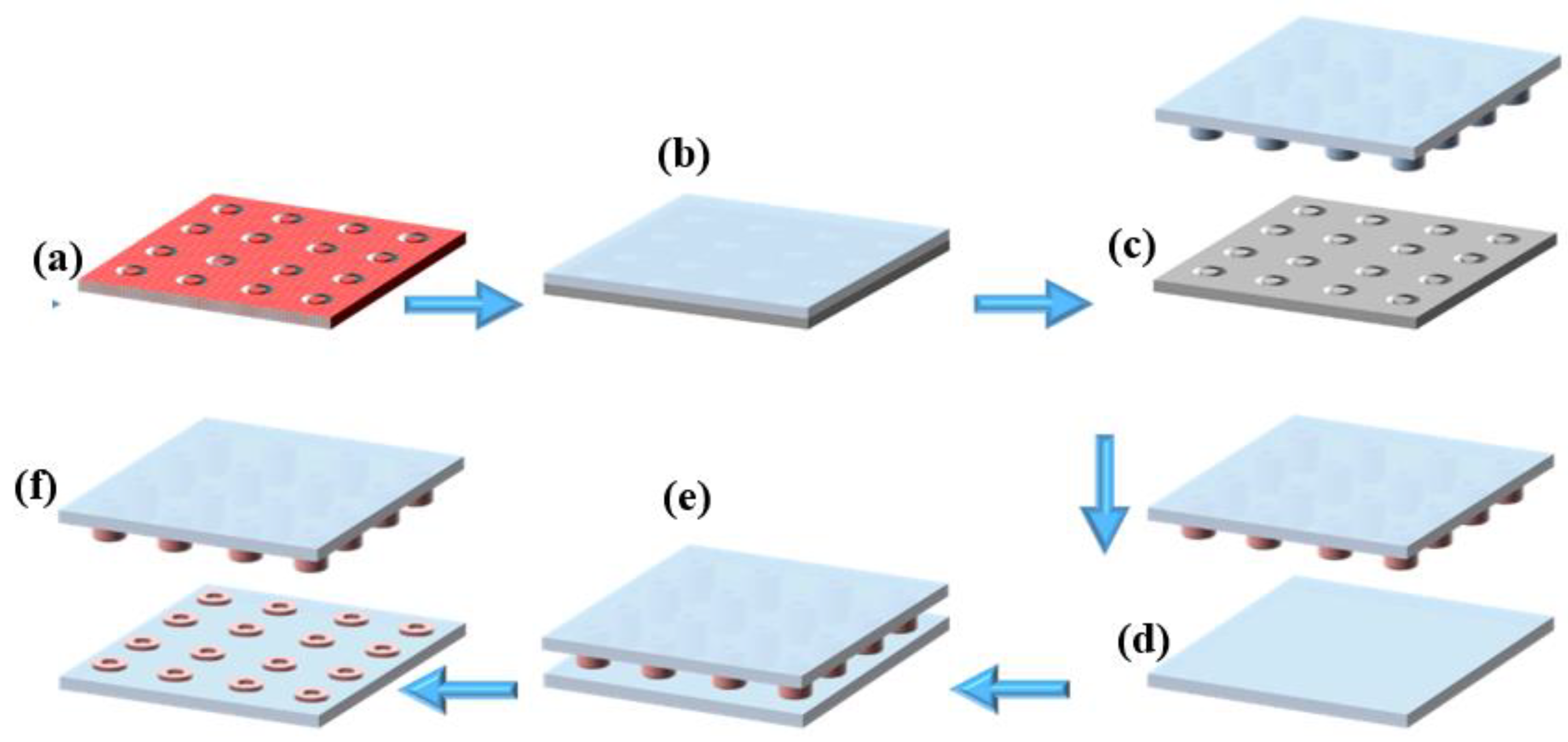

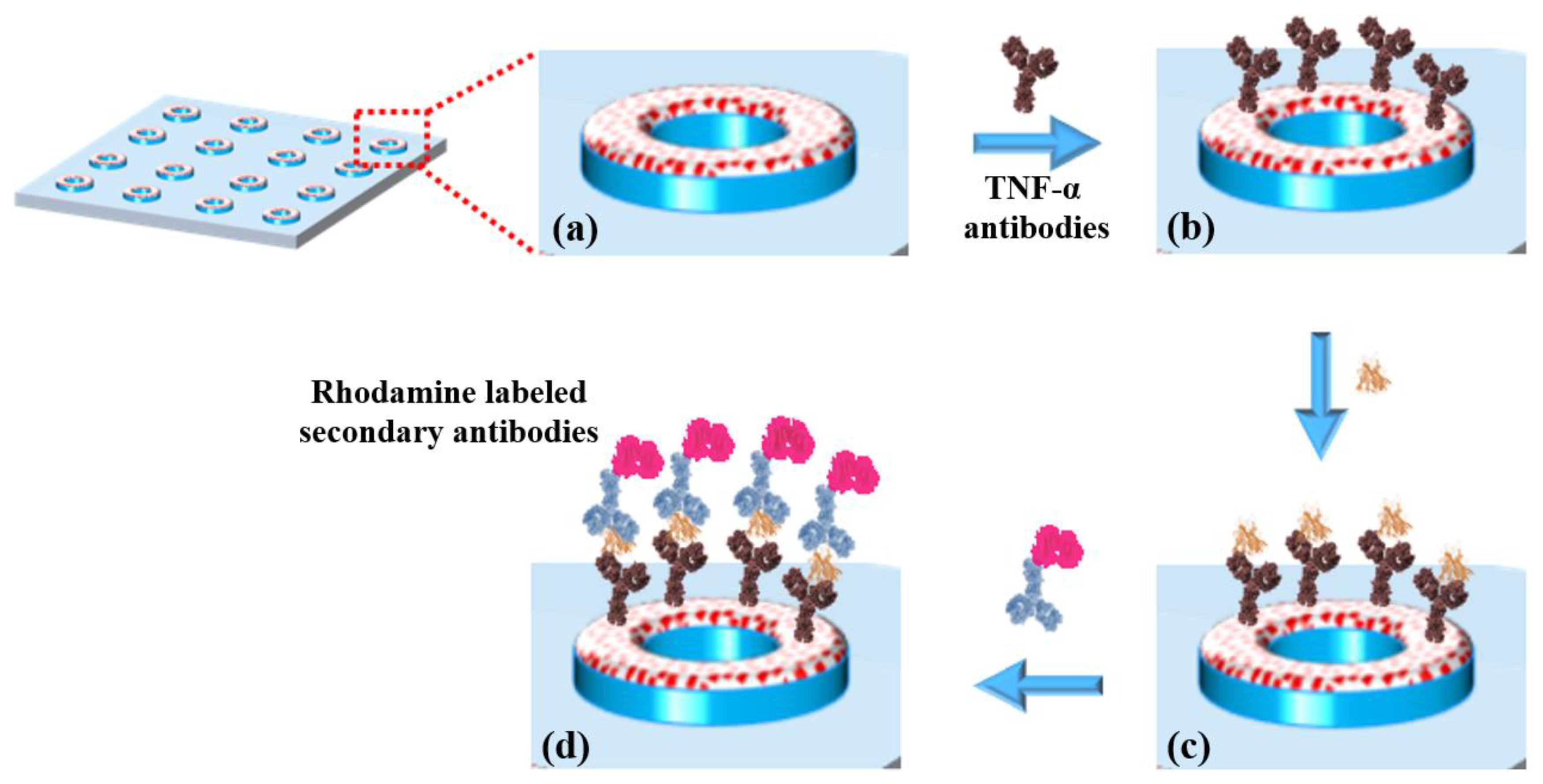

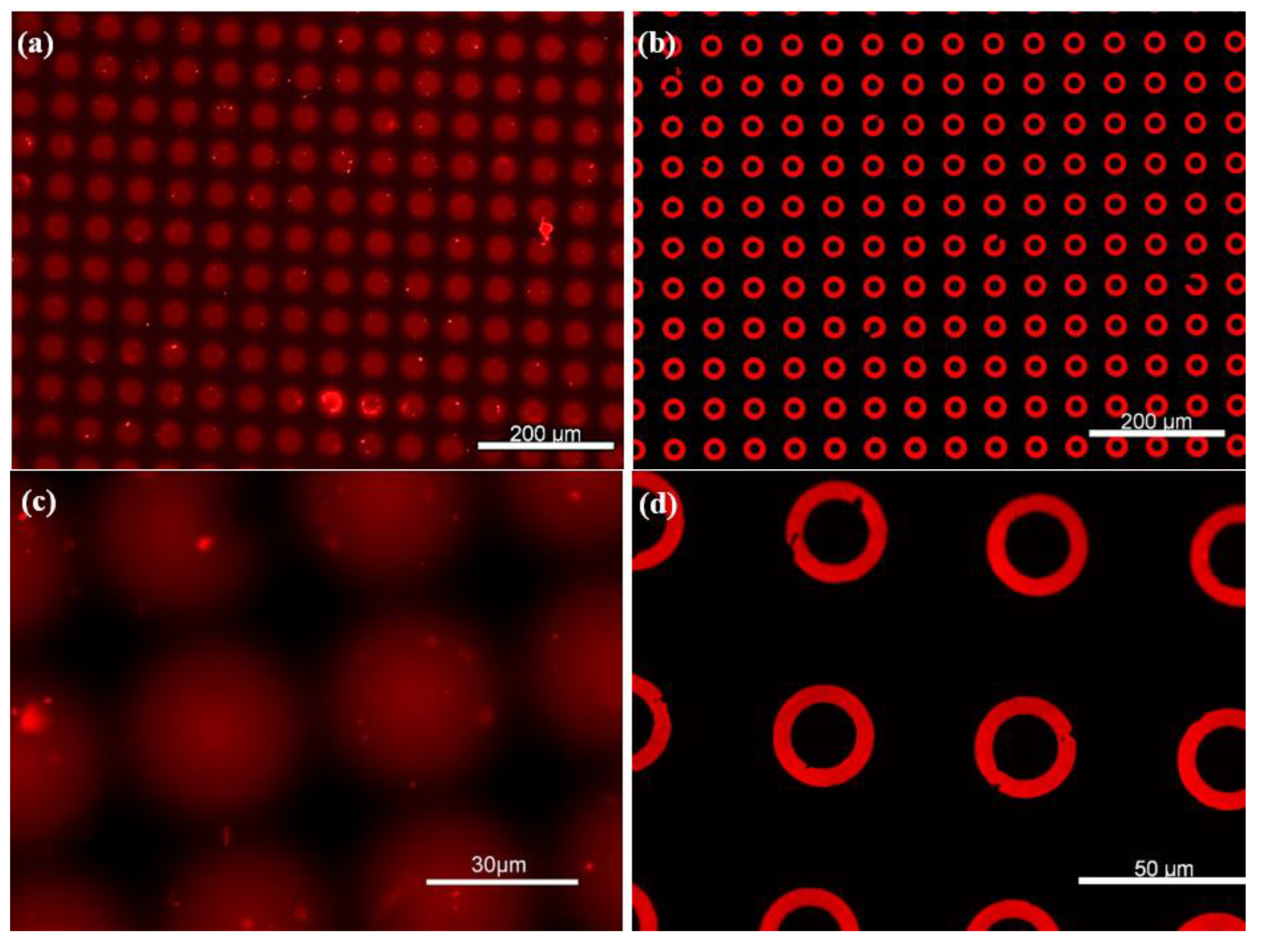


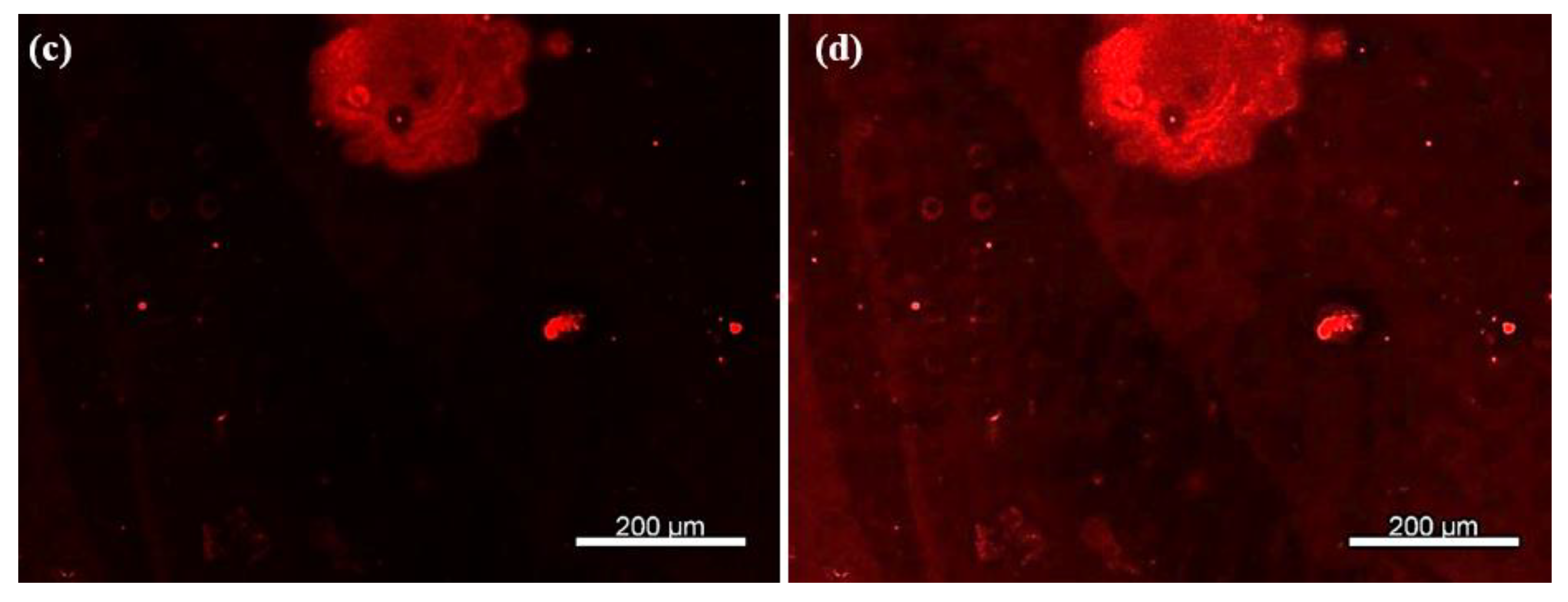
| PDMS | Plasma/O2 | PFDTS | |
|---|---|---|---|
| Contact angle (°) | 113.97 ± 1.24 | ~ 0° | 117.71 ± 1.2 |
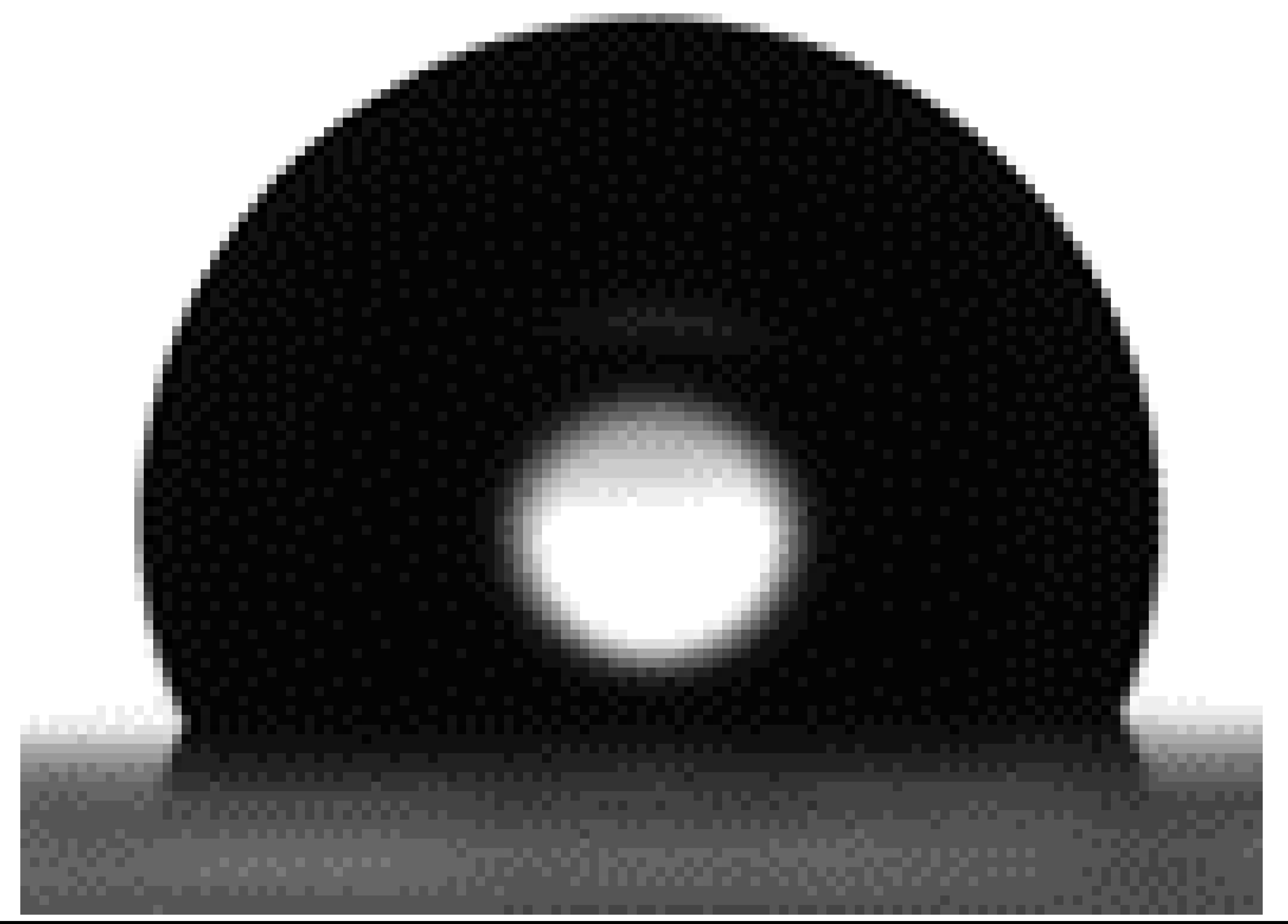 |  | 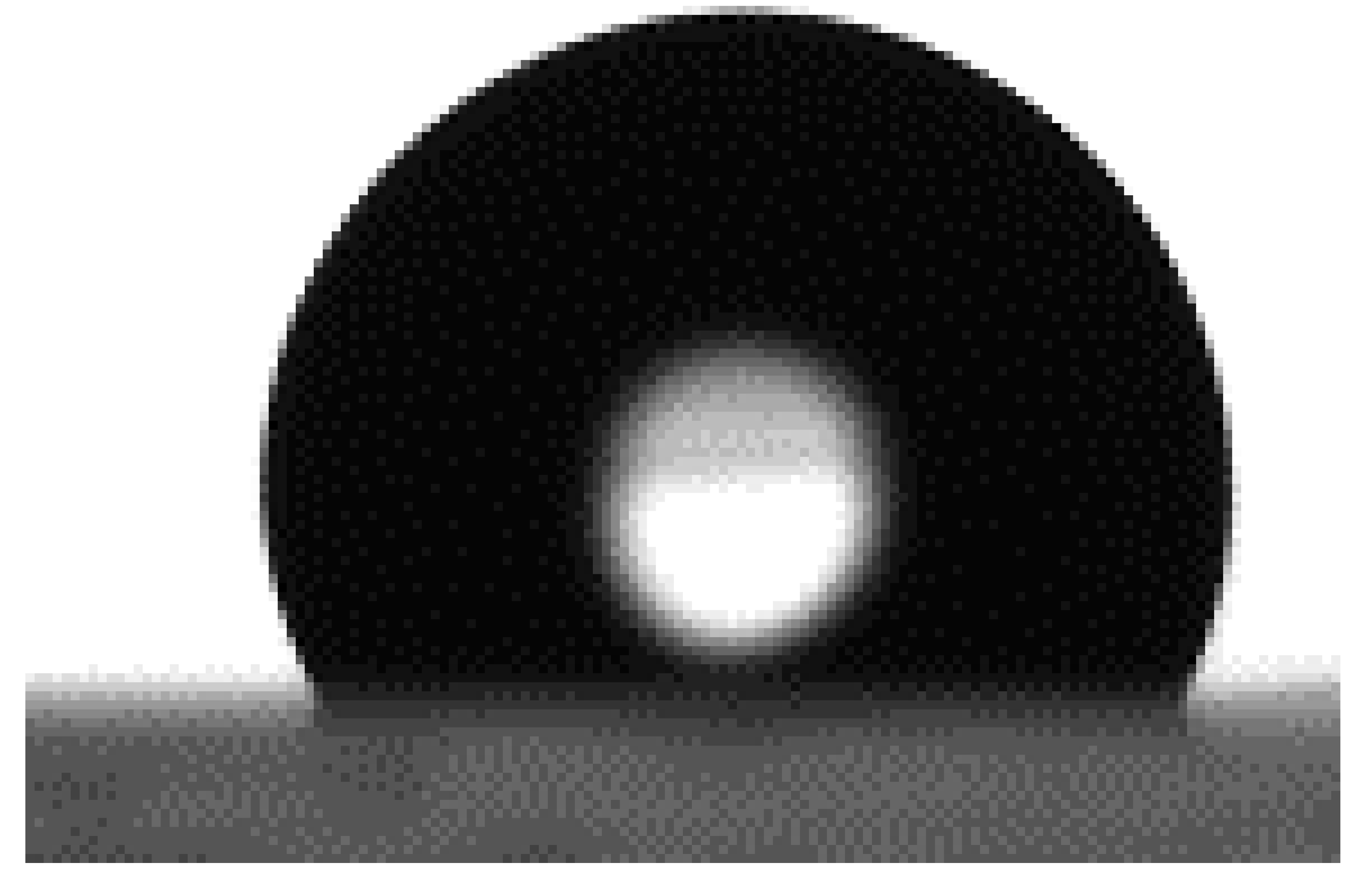 |
Disclaimer/Publisher’s Note: The statements, opinions and data contained in all publications are solely those of the individual author(s) and contributor(s) and not of MDPI and/or the editor(s). MDPI and/or the editor(s) disclaim responsibility for any injury to people or property resulting from any ideas, methods, instructions or products referred to in the content. |
© 2025 by the authors. Licensee MDPI, Basel, Switzerland. This article is an open access article distributed under the terms and conditions of the Creative Commons Attribution (CC BY) license (https://creativecommons.org/licenses/by/4.0/).
Share and Cite
Baraket, A.; Bonament, A.; Aarfane, A.; Nasrellah, H.; Bensemlali, M.; Bausells, J.; Jaffrezic-Renault, N.; Zine, N.; Errachid, A. Microcontact-Printed Optical Biosensor for Non-Invasive Detection of TNF-α: Point-of-Care Monitoring of Heart Failure. Chemosensors 2025, 13, 338. https://doi.org/10.3390/chemosensors13090338
Baraket A, Bonament A, Aarfane A, Nasrellah H, Bensemlali M, Bausells J, Jaffrezic-Renault N, Zine N, Errachid A. Microcontact-Printed Optical Biosensor for Non-Invasive Detection of TNF-α: Point-of-Care Monitoring of Heart Failure. Chemosensors. 2025; 13(9):338. https://doi.org/10.3390/chemosensors13090338
Chicago/Turabian StyleBaraket, Abdoullatif, Alexi Bonament, Abdellatif Aarfane, Hamid Nasrellah, Meryem Bensemlali, Joan Bausells, Nicole Jaffrezic-Renault, Nadia Zine, and Abdelhamid Errachid. 2025. "Microcontact-Printed Optical Biosensor for Non-Invasive Detection of TNF-α: Point-of-Care Monitoring of Heart Failure" Chemosensors 13, no. 9: 338. https://doi.org/10.3390/chemosensors13090338
APA StyleBaraket, A., Bonament, A., Aarfane, A., Nasrellah, H., Bensemlali, M., Bausells, J., Jaffrezic-Renault, N., Zine, N., & Errachid, A. (2025). Microcontact-Printed Optical Biosensor for Non-Invasive Detection of TNF-α: Point-of-Care Monitoring of Heart Failure. Chemosensors, 13(9), 338. https://doi.org/10.3390/chemosensors13090338








